Location Name: Izumotaisha - 出雲大社
Type: Shinto Shrine - 神社
Location: Izumo City, Shimane Prefecture
Access: JR Izumo-shi or Ichibata Izumotasha-mae
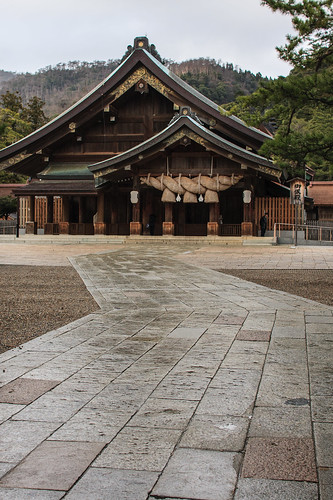 |
| The main shrine |
Izumotaisha is the second most important shrine to the Shinto faith. Only the Shrine in Izu is revered higher. Being the home to some of Japan’s oldest archeological finds Izumotaisha is also the oldest Shinto shrine. It abuts the hills that make up the Shimane Peninsula and separate the Izumo plain from the Japan sea. The plain is made up of relatively flat farm land that has been cut up with rivers and canals. It bears a slight resemblance to the Imperial Valley of California. To the east and west the plain is set between the Japan sea and the brackish Lake Shinji. The landscape is utilitarian, but not dramatic. That said, it does look like it was an ideal place for early humans to develop agriculture.
In the shinto faith it is believed that the gods all congregate in November at Izumotaisha. In basic Japanese the months named after their order. November becomes [10月] or “tenth month.” There is a secondary set of names for the months that appears in traditional calendars and dates. November’s traditional name is Kannazuki [神無月] literally “no gods month.”
The god enshrined at Izumotaisha is called Okuninushi who, as a young man, helped heal the White Rabbit of Inaba. He is known as the god of enmusubi [縁結び] or matchmaking. When one prays at the shrine it is custom to clap four times instead of the typical two. The first two claps are for yourself and the second two are for your future (or current) spouse. When I first came to Japan on a cold January night in 2006 I stumbled into Izumotaisha late one night and prayed for my future clapping four times. In a mere two years later I married my amazing spouse Yuko. Now my experience might not match your own, but It’s worth a try if you’re looking. Enmusubi has also taken on the meaning of expanding one’s circle of friends and being more personable. Charms, amulets and chopsticks enchanted with the spirt of enmusubi are sold in the shrine and stores around it.
The shrine’s buildings have a design that is unlike any other one that you might have visited. I find the design helps produce a sense of awe and mystery when exploring the site. Everything from the trees in the garden to the moss growing on the roof have an aura of august maturity. As is common with Shinto shrines, the gardens and walkways leading to the buildings all glorify nature it’s elegant power.
Located to the side of the main temple complex is the Kaguraden. Dating from 1776, the building itself is new looking and not as appealing as the unique design of the main shrines. It does have a the largest shimenawa, a type of devotional rope made of straw, weighing 5 tons hanging from the 13.5 meter long entranceway. A popular sight typically shown on most of the pamphlets advertising the shrine to tourists. I cannot recommend a visit to Izumotaisha and the San’in area more.
 |
| Parts of the shrine are still being repaired |
The god enshrined at Izumotaisha is called Okuninushi who, as a young man, helped heal the White Rabbit of Inaba. He is known as the god of enmusubi [縁結び] or matchmaking. When one prays at the shrine it is custom to clap four times instead of the typical two. The first two claps are for yourself and the second two are for your future (or current) spouse. When I first came to Japan on a cold January night in 2006 I stumbled into Izumotaisha late one night and prayed for my future clapping four times. In a mere two years later I married my amazing spouse Yuko. Now my experience might not match your own, but It’s worth a try if you’re looking. Enmusubi has also taken on the meaning of expanding one’s circle of friends and being more personable. Charms, amulets and chopsticks enchanted with the spirt of enmusubi are sold in the shrine and stores around it.
 |
| A 2006 photo of the shrine. This area is currently under construction as of January, 2013 |
 |
| Kaguraden and shimenawa |
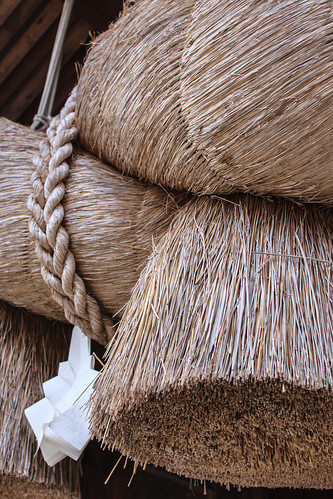 |
| Shimenawa |
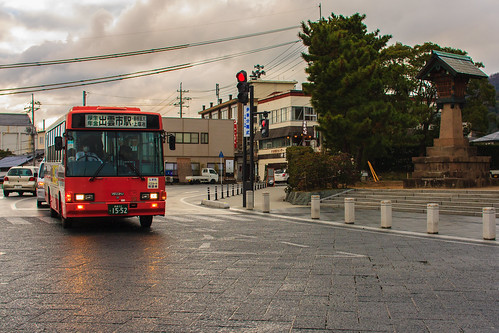 |
| Main entrance |
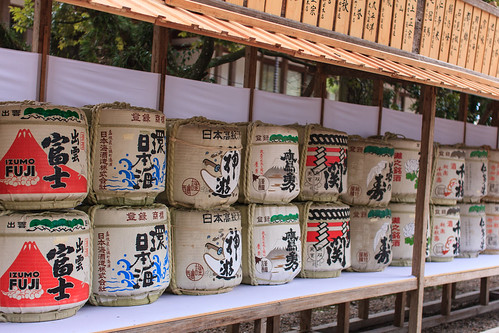 |
| New Year's sake on display |
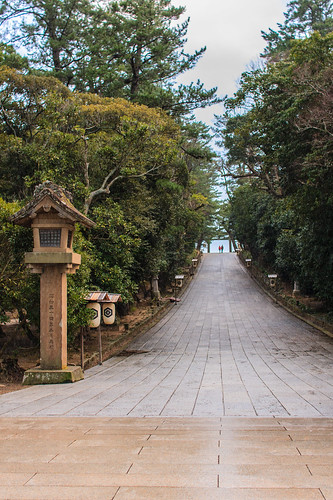 |
| Looking back towards the entrance |
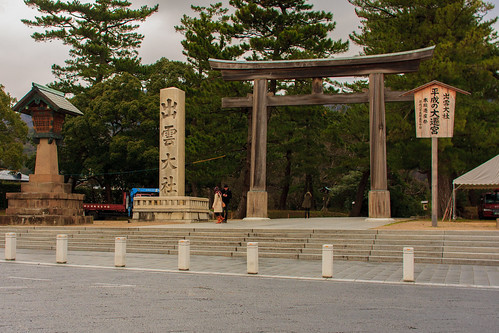
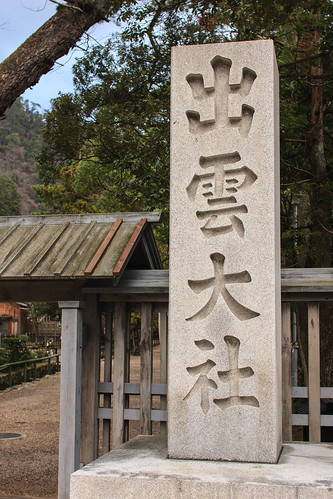
4 comments:
Absolutely Beautiful !
cheers, parsnip
The place looks very scenic and lovely. The New Year sake astonish me, that's big in my opinion.
The shrines look stunning and seems much bigger to the ones I went to Kamakura.
The 2006 night photo really struck me. I wonder how long it would take to get there from where I am now.
@Lynn...
Take the train overnight from Tokyo
http://en.wikipedia.org/wiki/Sunrise_Izumo/Sunrise_Seto
or use the Seishun 18 Kippu. If you go direct from Tokyo you can reach Yonago or Okayama in one full day of train riding.
http://sleepytako.blogspot.jp/2012/03/seishun-18-kippu-pt2-planning.html
Post a Comment